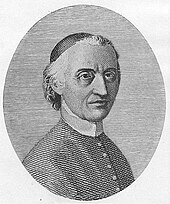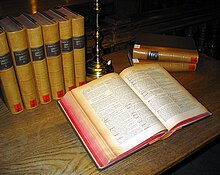Totius Latinitatis Lexicon
The Totius Latinitatis Lexicon (German Lexicon of the entire Latinity ) is a lexical dictionary of the Latin language, which Egidio Forcellini created in decades of work in the 18th century and which was first published in four volumes in 1771. It was widely used and had a significant influence on later works of this type.
Shortly after entering the seminary of Padua , Egidio Forcellini began to assist Jacobo Facciolati with the new editions of Cornelius Schrevelius ' Lexicon manuale Graeco-Latinum and the Dictionarum Latinum by Ambrosius Calepinus . In doing so, he realized that the content of the Italian dictionary of the Accademia della Crusca also needed one for the Latin language. The importance of his teacher Facciolati for the further work, which he initially also actively accompanied, is clearly visible, decades later, when it was first published, it was mentioned in the title before Forcellini. In 1718 Forcellini began to work on the Totius Latinitatis Lexicon , the lexicon of all of Latinity . For this purpose, he used all written sources that were known to him: literary sources, even if they were only passed down in fragments, inscriptions and coin legends . The aim was to record all voces from the archaic beginning to the end of late antiquity .

Forcellini made an ancient Greek or Italian - sometimes both - translation for each entry . Unlike Schrevelius in his Dictionarum Latinum , Forcellini refrained from further translations into other languages. At this point Forcellini offers a Latin paraphrase. He only offers etymologies if they really seem likely to him. First it offers the original meaning of a word, then the transferred meanings. Words that originate from archaic times or were no longer in use are also marked. Nevertheless, there are often recourse to archaic words when the age of a term should be clarified. He used this approach in later Latin literature only when no earlier evidence was found. Forcellini clarifies questions about orthography on the basis of direct sources from antiquity such as epigraphic and numismatic inscriptions. If there are variants, the forcellini is most likely put first, but the others are also mentioned. He also goes into the prosody . An index auctorum et operum can be used to determine which works he used .
Due to external circumstances, Forcellini had to interrupt his work several times, sometimes for longer periods of time. After more than 40 years of work, the work was available in fair copy in 1761. It was another ten years before it went to press. Forcellini died three years before the first edition. So he no longer saw the success of his work. The work was reprinted and reprinted many times. Appendices and supplements were added several times, thus expanding the work. The second edition with supplements, published in 1805, appeared as early as 1805, and a new edition created between 1827 and 1831 comprised 5,000 more word entries and contained 10,000 corrections. A London edition was published in 1826/27, and a German version between 1828 and 1835 by Robert Schumann's brother Carl Schumann (1801–1849) in Schneeberg . The importance of the work is not least characterized by the fact that in the preface to the first volume of the Thesaurus Linguae Latinae only the Totius Latinitatis Lexicon and Johann Matthias Gesner's Novus Thesaurus were mentioned by name as predecessors.
expenditure
- Totius Latinitatis lexicon, consilio et cura Jacobi Facciolati opera et studio Aegidii Forcellini, lucubratum. 4 volumes, Typis Seminarii, Padua 1771 ( digitized version ).
- Totius Latinitatis lexicon, consilio et cura Jacobi Facciolati opera et studio Aegidii Forcellini lucubratum. In hac tertia editione auctum et emendatum a Josepho Furlanetto. 4 volumes, Typis Seminarii, Padua 1827–1831.
- Totius latinitatis lexicon, opera et studio Aegidii Forcellini lucubratum. Et in hac editione post tertiam auctam et emendatam a Josepho Furlanetto alumno seminarii patavini. Novo ordine digestum amplissime auctum atque emendatum cura et studio Vincentii De Vit. Typis Aldinianis, Prati 1858–1879.
- Lexicon totius latinitatis J. Facciolati, Aeg. Forcellini et J. Furlanetti seminarii patavini alumnorum cura, opera et studio lucubratum nunc dedmum juxta opera R. Klotz, G. Freund, L. Doderlein aliorumque recentiorum auctius, emendatius melioremque in formam redactum curante doct. Francisco Corradini ejesdem seminarii alumno. Typis Seminarii, Padua 1896.
literature
- Gerardo Bianco: Forcellini, Egidio. In: Fiorella Bartoccini (ed.): Dizionario Biografico degli Italiani (DBI). Volume 48: Filoni-Forghieri. Istituto della Enciclopedia Italiana, Rome 1997.
- Marcus Beck: Forcellini, Egidio. In: Peter Kuhlmann , Helmuth Schneider (Hrsg.): History of the ancient sciences. Biographical Lexicon (= The New Pauly . Supplements. Volume 6). Metzler, Stuttgart / Weimar 2012, ISBN 978-3-476-02033-8 , Sp. 408-410.
Web links
- Egidio Forcellini . In: Catholic Encyclopedia (English)
- Lexicon Totius Latinitatis Online - searchable
